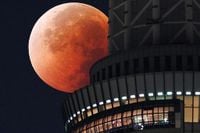Millions of stargazers across the globe turned their eyes skyward on the night of September 7-8, 2025, as the year's second total lunar eclipse—famously known as a "blood moon"—bathed the moon in a deep, mesmerizing red. For over five hours, Earth’s shadow crept across the lunar surface, culminating in a period of totality that lasted a remarkable one hour and 22 minutes, according to the Associated Press. This celestial spectacle, while not uncommon in the grand scheme of cosmic events, offered a visual treat that delighted observers from Saudi Arabia to the Philippines and from the Arctic Ocean down to Antarctica.
Unlike the March 2025 eclipse, which favored the Americas, this event was a gift to Asia, parts of East Africa, and the western half of Australia. As reported by Al Jazeera, "Asia, including India and China, were best placed to see Sunday’s total eclipse," with the moon turning a rusty red as it passed through Earth’s shadow. Even the eastern edge of Africa and western Australia caught the full show, while Europe and the rest of Africa enjoyed partial views as the moon rose in the early evening.
For those lucky enough to be in the right place at the right time, the experience was both awe-inspiring and accessible. As Ryan Milligan, an astrophysicist at Queen’s University Belfast, explained to AFP, "The moon appears red during lunar eclipses because the only sunlight reaching it is reflected and scattered through the Earth’s atmosphere." The science behind the color is a phenomenon called Rayleigh scattering—blue wavelengths of light are scattered out by the atmosphere, leaving the longer, red wavelengths to paint the moon in eerie hues. As Space.com described, "a phenomenon known as Rayleigh scattering saw the moon adopt a bloody red hue, as sunlight scattered by Earth's atmosphere was bent onto the lunar surface."
Unlike solar eclipses, which demand special glasses or pinhole projectors for safe viewing, lunar eclipses are entirely safe to watch with the naked eye. All that’s required is clear weather and a good vantage point. This accessibility, combined with the event’s rarity and beauty, drew crowds to beaches, rooftops, and city parks across continents. In Odesa, Ukraine, beach-goers watched the eclipse above the Black Sea, while in central Athens, the blood moon appeared to rest gently in the hands of the ancient goddess Irene’s statue, as captured by photographer Angelos Tzortzinis and highlighted by BBC Sky at Night Magazine.
The visual drama unfolded in stages. As the eclipse began, Earth's inner shadow, or umbra, slowly encroached on the lunar disk. In Shanghai, Hector Retamal photographed the shadow advancing across the vast lunar maria, while in Pakistan, Aamir Qureshi captured the moon moments before it was swallowed in darkness. By the time totality arrived, the moon’s surface glowed a deep red, with its familiar craters and maria rendered in ghostly relief. Fabrice Coffrini’s image from Riex, Switzerland, showed the moon at its most dramatic, while in Tokyo, the blood moon perched atop the Skytree tower, creating a scene that looked almost staged for the occasion.
Photographers and amateur astronomers across the globe documented the event from far-flung locales. BBC Sky at Night Magazine received images from Chennai, India; Lecce, Italy; Ahmadabad, Iran; Stonehenge in the UK; Leiria in Portugal; and as far east as Shanghai and Tokyo. In Istanbul, the moon hovered over the Temple of Apollo, while in Barcelona, it loomed above the iconic Sagrada Familia. The eclipse was visible in Germany around 8 pm CET, and in Rome, it shone through the famous statue of the Capitoline she-wolf, adding a touch of mythic grandeur to the night.
According to Space.com, “over seven billion people had a direct line of sight” to the eclipse. The event’s reach was truly global, with only the Americas missing out on the main show. In Europe, viewers caught a glimpse of the partial eclipse as the moon rose, while in Lisbon, the moon remained partially covered by Earth's shadow even after totality had passed. In Denmark, the blood moon was seen south of Copenhagen, and in Athens, its red disk contrasted beautifully with the city’s ancient monuments.
The phenomenon of the blood moon has captivated humanity for millennia, inspiring both wonder and superstition. But as scientists like Milligan emphasize, the explanation is straightforward: “That’s what gives the moon its red, bloody colour.” The precise alignment of the sun, Earth, and moon is required for a total lunar eclipse, with Earth’s shadow falling directly across the lunar surface. After the period of totality, the moon gradually slipped out of the umbra, returning to its familiar silvery glow—a process beautifully documented by photographers like Hussein Faleh in Iraq, who even caught a passenger plane skimming the moon’s edge as the shadow receded.
For those who missed this event, patience will be required: the next total lunar eclipse visible from much of the world won’t occur until New Year’s Eve 2028, as reported by Der Spiegel. However, there’s a consolation prize on the horizon. In just two weeks, a partial solar eclipse will grace the skies, visible from New Zealand, a sliver of Australia, and Antarctica. Stargazers hoping to catch that event, or the total solar eclipse of August 2026, will need to use proper eye protection—a reminder that, while lunar eclipses are safe to enjoy with the naked eye, solar eclipses demand caution.
The September 2025 blood moon was more than just an astronomical event; it was a shared moment of beauty and curiosity for billions. From city rooftops to ancient temples, from bustling metropolises to quiet beaches, people came together to witness the dance of shadows and light that connects us all to the cosmos. As the moon returned to its regular sheen, many were left with a sense of awe—and perhaps a little more appreciation for the wonders above.






